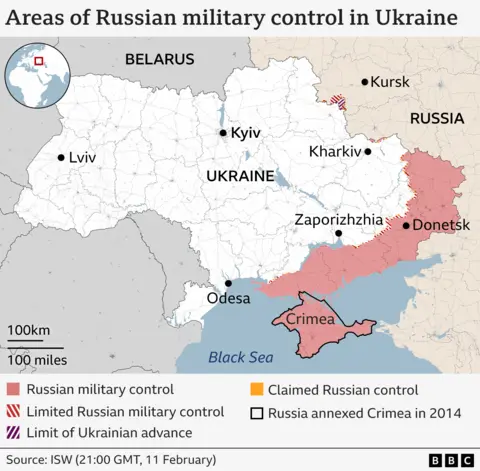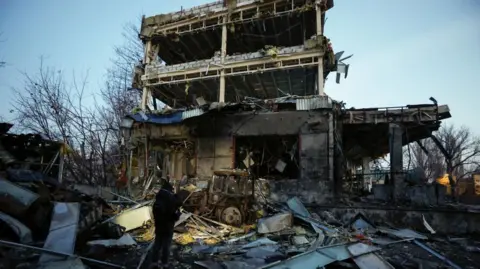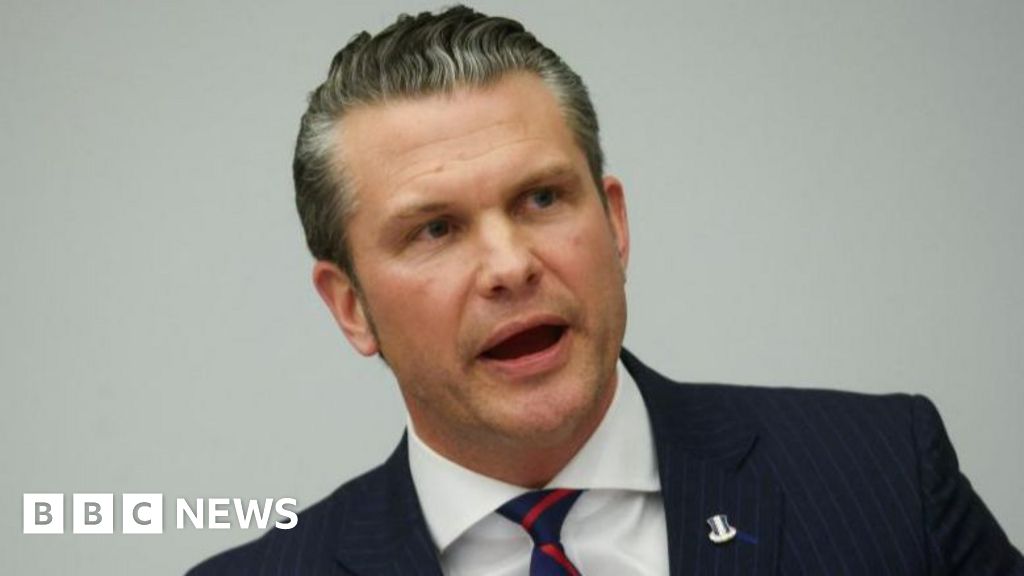Security correspondent
European nations must provide the “overwhelming” share of funding for Ukraine, the new US Defence Secretary Pete Hegseth has said, as he signalled a drastic shift in Washington’s position on the war.
Speaking at a defence summit in Brussels, Hegseth said the US would no longer “tolerate an imbalanced relationship” with its allies and called on Nato members to spend much more on defence.
He also said it was “unrealistic” to expect Ukraine to return to its pre-2014 borders and downplayed the prospect of Ukraine joining Nato.
The comments came as Donald Trump and Vladimir Putin held a “lengthy” phone call in which they agreed to begin negotiations to end the war.
The new US defence secretary’s remarks are the clearest indication yet of the Trump administration’s position on the Ukraine war and what a peace plan to end the conflict could involve.
The positions set out by Hegseth will be met with dismay in Ukraine – which has repeatedly called for Nato membership and has rejected ceding territory as part of any peace deal – and will be welcomed by Moscow.
There will also be nervousness across the continent after Hegseth suggested the US would significantly scale back its support for Ukraine, insisting that European nations would now need to provide the “overwhelming share” of aid to Kyiv.
Hegseth, who was appointed defence secretary after Donald Trump returned to the US presidency in January, was speaking at the Ukraine Defence Contact Group, a meeting of more than 40 countries allied to Ukraine.
He said: “We want, like you, a sovereign and prosperous Ukraine.
“But we must start by recognising that returning to Ukraine’s pre-2014 borders is an unrealistic objective.
“Chasing this illusionary goal will only prolong the war and cause more suffering.”
Russia annexed the Black Sea peninsula of Crimea from Ukraine in March 2014 and then backed pro-Russian separatists in an armed insurgency against Kyiv’s forces in eastern Ukraine.
Moscow currently controls around a fifth of Ukraine’s territory, mainly in the east and south.

Hegseth said any durable peace must include “robust security guarantees to ensure that the war will not begin again”.
However, he said “the United States does not believe that Nato membership for Ukraine is a realistic outcome of a negotiated settlement”.
Instead, security guarantees should be backed by “capable European and non-European troops”.
“If these troops are deployed as peacekeepers to Ukraine at any point, they should be deployed as part of a non-Nato mission and they should not be covered under Article 5,” he said, referring to the alliance’s mutual defence clause.
Hegseth also told Nato’s European members that they would need to provide the lion’s share of future aid for Kyiv, warning that Washington “will no longer tolerate an imbalanced relationship” with its allies.
“Safeguarding European security must be an imperative for European members of Nato,” Hegseth said. “Europe must provide the overwhelming share of future lethal and non-lethal aid to Ukraine.”
The US has been Ukraine’s biggest financial and military backer but Trump has been repeatedly critical of US aid spending and has said his priority is to end the war, which escalated in February 2022 after Russia’s full-scale invasion.
Hegseth echoed calls by Trump for Nato allies to increase their defence spending to 5% of their GDP, instead of the current 2% target – saying the latter is “not enough”.
The US currently spends roughly 3.4% of its GDP on defence, while the UK spends about 2.3%. Countries closer to Russia, like Poland and the Baltic states, spend the most proportionately at around 4%.
 EPA
EPAIt will be difficult for Ukraine to hold back Russia’s advances without the same scale of support provided by Washington during Joe Biden’s administration.
While Russia is losing large numbers of troops in the conflict, the country’s commanders are prepared to throw everything at Ukrainian front lines.
Russia is also now spending more on defence than the whole of Europe combined, according to figures from The Military Balance, an annual comparison of the strengths of armed forces around the world.
Earlier this week, Ukrainian President Volodymyr Zelensky said he was ready to negotiate a peace deal with Russia but wanted his country to do so from a “position of strength”.
Speaking to the Guardian, Zelensky said if Trump was able to get Ukraine and Russia to the negotiating table, the Ukrainian president planned to offer Russia a straight territory exchange, giving up land Kyiv has held in Russia’s Kursk region since the launch of a surprise offensive six months ago.
“We will swap one territory for another,” he said, but added that he did not know which part of Russian-occupied land Ukraine would ask for in return.
Zelensky also said he would offer US firms lucrative contracts to rebuild Ukraine, in an apparent attempt to get Trump onside.
In November last year, he and the US president spoke following Trump’s election victory.
Zelensky said he had a “constructive exchange” with the then president-elect and that he was certain the war with Russia would “end sooner” than it otherwise would have once Trump became president.
But Trump’s Democratic opponents have accused him of being too close to Russian President Vladimir Putin and say his approach to the war amounts to surrender for Ukraine, which would in turn endanger all of Europe.
It also remains unclear whether a diplomatic solution to the war could be reached anytime soon that would be acceptable to both sides.


